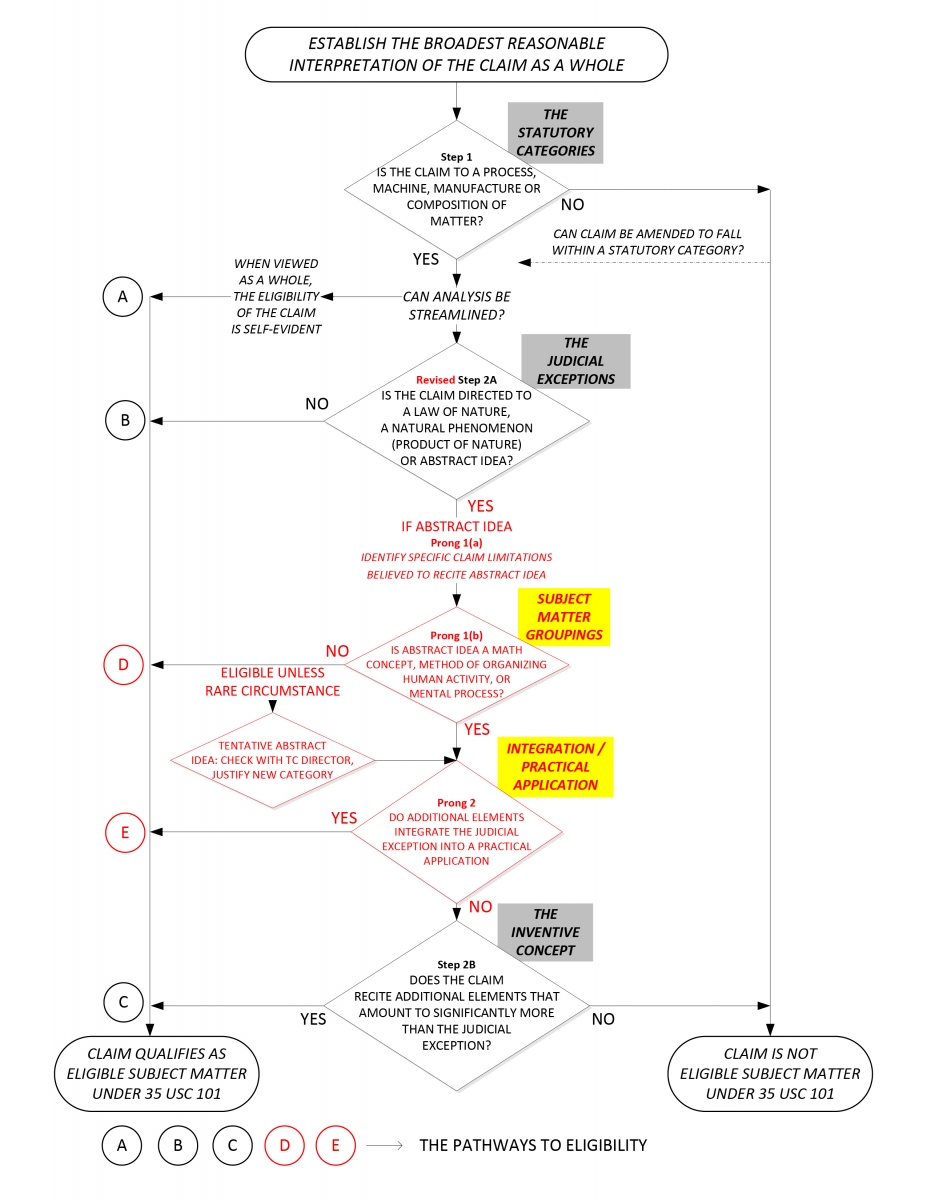
New 101 Guidance from USPTO – What Does It Change?
On January 4th, the USPTO announced revised guidance for subject matter eligibility (Section 101 Revised Guidance) and stated it would take effect when published on Monday, January 7, 2019.
The guidance is addressed to all personnel of the U.S. Patent and Trademark Office (or PTO)—both the government employees that initially evaluate patent applications for compliance with title 35 of the U.S. Code and the administrative judges that review disputes on these issues.[1] This new guidance deals with Section 101 of that title—the threshold question of whether a patent’s claimed subject matter is within the realm of topics that are even “eligible” for patenting. Courts have held that “abstract ideas” do not meet this eligibility threshold.
Consistent with PTO Director Iancu’s stated views, the new guidance emphasizes judicial precedent favoring eligibility under 35 U.S.C. § 101 and downplays cases that found claims ineligible. The guidance states that its goals are to “increas[e] predictability and consistency in the patent eligibility analysis” and “increase consistency in examination practice.”[2]
If followed faithfully by Examiners, this new guidance should mark a drastic course correction for how patents—and particularly software patents—are examined. The guidance accomplishes this course correction in numerous ways:
- It distills three “enumerated groupings” of ineligible abstract ideas from judicial precedent. Anything outside those groupings “should not be treated as too abstract” except in “rare” circumstances. In such rare cases, Examiners must obtain specific approval from a highly-placed “Technology Center Director” to reject these unusual claims under Section 101.[3]
- It requires Examiners to find claims eligible if they “integrate” any abstract ideas into a “practical application.” It emphasizes that mere inclusion of an abstract idea in a claim is not fatal, since such ideas form the basic building blocks of all patent claims. It does not require the practical application itself to be unconventional (for purposes of eligibility).[4]
- It adds additional examples of how elements can be integrated into eligible practical applications, such as by implementing or using abstract ideas with a particular object “that is integral to the claim.” It emphasizes these examples are not an exclusive list.[5]
- It characterizes counter-examples—cases where an abstract idea has not been integrated into a practical application and are thus ineligible—narrowly. These counter-examples include the hypothetical situation discussed in the Alice case where an abstract idea is claimed and appends only the instruction to “apply it,” without more.[6]
- It instructs Examiners not to shortcut the process by simply labeling claim elements “well-understood, routine, conventional activity” early in their analysis. The “routine...” question must now be addressed only in the last step. It reiterates that Examiners support assertions of routineness with a “factual determination,” as initially explained in the Berkheimer memo of April 2018.[7]
- It invites Examiners to find claims eligible under every analytical step, re-framing the previous emphasis on phrases like “routine and conventional” and suggesting that even gathering data can be eligible if accomplished “in an unconventional way.” The guidance requires Examiners to “reevaluate” several aspects of claims if they are not found eligible in a previous analytical step, providing more pathways to eligibility.[8]
It is now much easier and faster for Examiners to find claims eligible unless they are very broad and very abstract. A contrary finding—particularly for a long and detailed claim—requires much more analysis, justification, and work by the Examiner.
The PTO outlined its old procedure with a flowchart. Viewing the new guidance in a similar flowchart format, Examiners now have at least two additional “paths to eligibility,” labeled as paths C and D in the figure below. Step 2A, prong 1(a) requires identification of “specific claim limitations,” a change that also favors patent eligibility.

As evident from this chart, the new guidance changes the incentive structure for Examiners.[9] Eligibility is favored, with multiple off-ramps to this result. In contrast, to find ineligibility an Examiner faces a singular and difficult gauntlet. If applied as intended, this new guidance will generally result in more efficient (or “compact”) patent prosecution and lead to more consistent and predictable outcomes. For those seeking patents, this is a welcome clarification and improvement.
While the guidelines cite and fairly summarize numerous relevant cases, it is not clear how the courts will react. When findings of patent ineligibility have been appealed in recent years, the Patent Trial and Appeal Board has often cited the Federal Circuit’s Electric Power Group opinion to affirm these findings. The guidance does not address this opinion, although it is discussed in parallel guidance on 35 U.S.C. § 112. Thus, despite easier sailing at the PTO for patent eligibility, applicants should proceed with caution with an eye to obtaining patents that will also be enforceable in federal court.
[1] Department of Commerce, United States Patent and Trademark Office; 2019 Revised Patent Subject Matter Eligibility Guidance, 84 Fed. Reg. 4 at 51 (Jan. 7, 2019), available at
https://www.govinfo.gov/content/pkg/FR-2019-01-07/pdf/2018-28282.pdf (“All USPTO personnel are, as a matter of internal agency management, expected to follow the guidance.”).
[2] Id. at 53.
[3] Id. at 53, 57.
[4] Id. at 53–55.
[5] Id. at 55.
[6] Id.
[7] Id. (“Because revised Step 2A does not evaluate whether an additional element is well-understood, routine, conventional activity, examiners are reminded that a claim that includes conventional elements may still integrate an exception into a practical application, thereby satisfying the subject matter eligibility requirement of Section 101.”)
[8] Id. at 55–56.
[9] The PTO has now created its own updated flowchart, included at page 17 in these slides from the January 10, 2019 Patent Quality Chat, as well new subject matter eligibility examples 37–42. The PTO’s slide 35 warns that although eligible examples remaining eligible, older examples 1–36 should be used “with caution” because their related analysis “may not be entirely consistent with” the new guidance.
